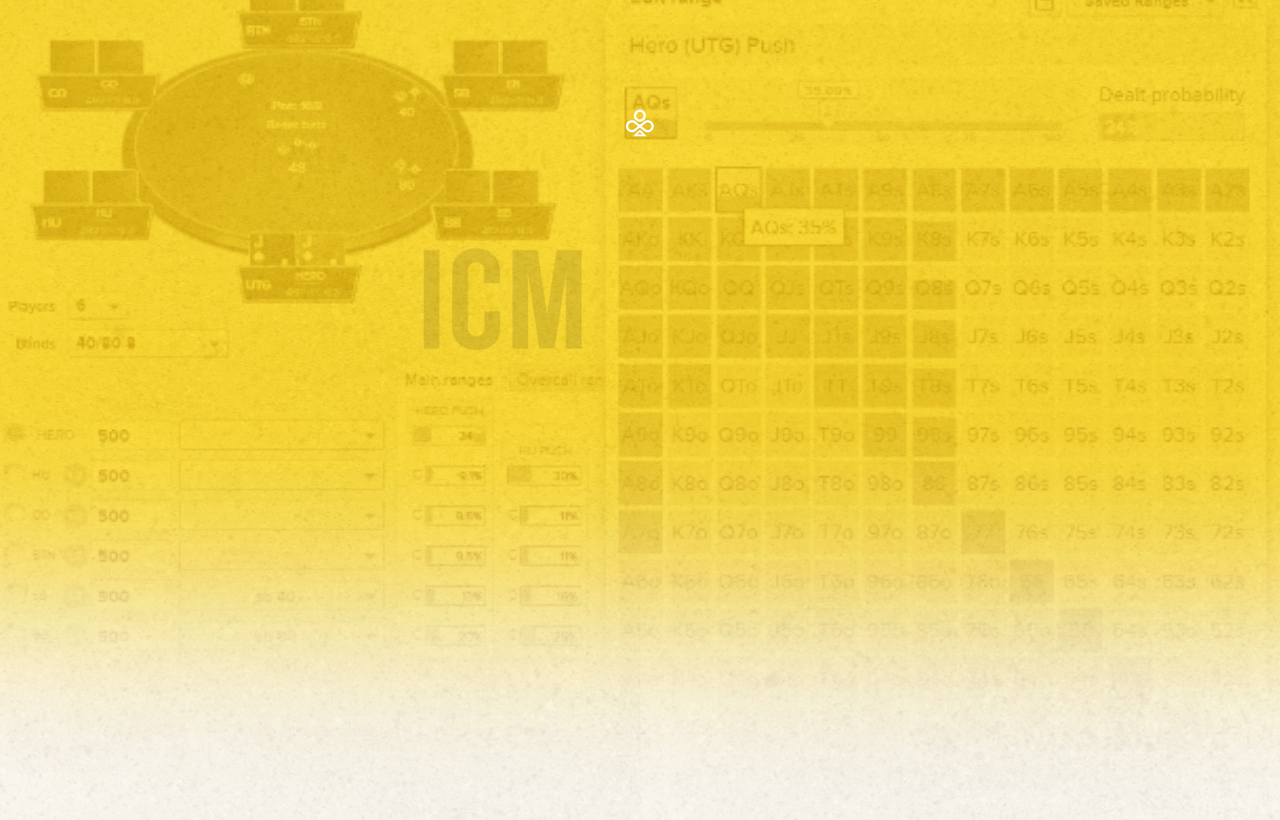ICM: The Basic Concept in Tournament Poker (MTT)
26/03/2024

If you're a Tournament Poker Player (MTT), then this article is for you! Find out everything you need to know to get to know the concept better ICM.
What is ICM in Poker?
ICM stands for Independent Chip Model, which literally means Independent Chip Model. It's a calculation model that allows poker players to assign a monetary value to their chips. stack of chips at a specific point in the tournament.
How does the ICM work?
The fundamental idea behind ICM is to help analyze the risk of a particular move, i.e. the amount of chips the player has is taken into account in direct comparison with the opponents and the prizes. Mind you, everything will depend on the player's current situation in the tournament.
How is the ICM calculated?
Well, to calculate the ICM manually would be quite complex. Therefore, players generally use poker software available online.
All the player has to do is enter the values requested in each field, e.g. number of players, payouts, players' stacks, and the software will tell them whether a given move “is +EV or not”.
Read the article on how the software works ICMIZER – “What is ICMizer?”
What is ICM calculation poker software for?
The calculations of ICM should mostly be considered in the most decisive stages of the tournament, especially in the final moments, i.e. the ITM bubble, semi-FT and the FT itself. More specifically, we can see some examples of the usefulness of calculating ICM:
Example 1: You're in a FT, with 6 other players still playing, in 4th position.
You have 3 stacks bigger than yours, which are constantly putting pressure on you. This is because there are 3 smaller ones, which don't allow you to reshover as much as you could in a similar situation without the factor ICM. Software like ICMizer allows you to adapt your range in the best way possible in these circumstances.
Example 2: You're in a FT, with 4 other players, and you're in last place.
As in the previous example, there are the big stacks putting pressure on the short and middle stacks. But in this scenario you're in last place. How much wider can your push range be compared to the previous situation? You can also use the ICMizer to draw your own conclusions and compare different scenarios. In this way, you can compare and understand the different weight that the ICM has in each of them.
Example 3: You're in a FT, with 2 other players, and you all agree on make a deal of the remaining slice of the prizepool that have yet to be distributed.
In other words, to know the value of your stack in $ at that moment in the tournament, in order to make the fairest deal, the deal calculation should be used taking into account the ICM.
What is Bubble Factor and the pressure from ICM?
The bubble factor is a factor that indicates an increase in equity necessary for the player to take a certain action. It's important to remember that the greater the bubble factor, more equity you need to give call/raise/bet and, consequently, more tight you have to play.
ICM: Why is it only used in tournaments?
The reason why ICM that exists only in tournaments is quite simple. In a tournament, even if the player wins all the chips, he will only win a percentage of the prize pool. In turn, having 10% of all the chips in play doesn't make the player's stack worth 10% of the prize pool.
Unlike the cash tables, the value of the chips at a given moment in a tournament will depend on:
- Percentage of chips the player has compared to the total chips in play;
- Distribution of the prize pool;
- Distribution of chips in other players' stacks;
- Change in the value of chips over the course of the tournament, proportionally related to the probability of winning money.
How do different Stack Sizes make all the difference?
There are 3 “types” of stacks:
- The “Chip Leader”
If the player is Chip Leader, you can use all your tokens to threaten the players short stack who are probably just trying to survive. What's more, the player you can also take advantage of big stack to force good players who are forced to play tighter, taking into account the ICM. And the player must also do more 3-bet and shove to force the middle stacks doing fold.
- The “Medium Stack”
The medium stack is the player who has the most to lose in the FT. In other words, the player is 4th or 5th out of 9 players and is eliminated before the short stacks, this is the equivalent of losing quite a few dollars in reality. There is greater ICM pressure here.
- The “Short Stack”
The short stack is the one that suffers the least pressure from the ICM because it has the least to lose. However, in this position the player must play aggressively in order to increase his stack.
When the player is in this position, he can practically do shove with all hands +chipEV, except with some hands in certain positions.
Have you read the article ICM: does it impact the PKO strategy?
There are more factors that influence playing strategy, such as:
- What are the opponents' strategies?
If two players with large stacks of the final table are constantly fighting each other, so you'll probably want to play a lot more tight, even with a short stack.
- How are you perceived by your opponents?
If the players at your table think you are super tight, then you should capitalize on their perceptions and steal a lot small-to-medium pots, in order to avoid major risks.
- Is this your last hand of the game?
We mustn't forget that the ICM assumes that the tournament ends in one hand and therefore doesn't take into account the future value of risky plays.
In a nutshell ICM is very useful for the player to define a solid basic strategy in certain situations, but they must be prepared to adapt at any time. Don't consider 100% of your decision-making to be based on the ICM as an absolute truth.
Inspirational articles:



Comments